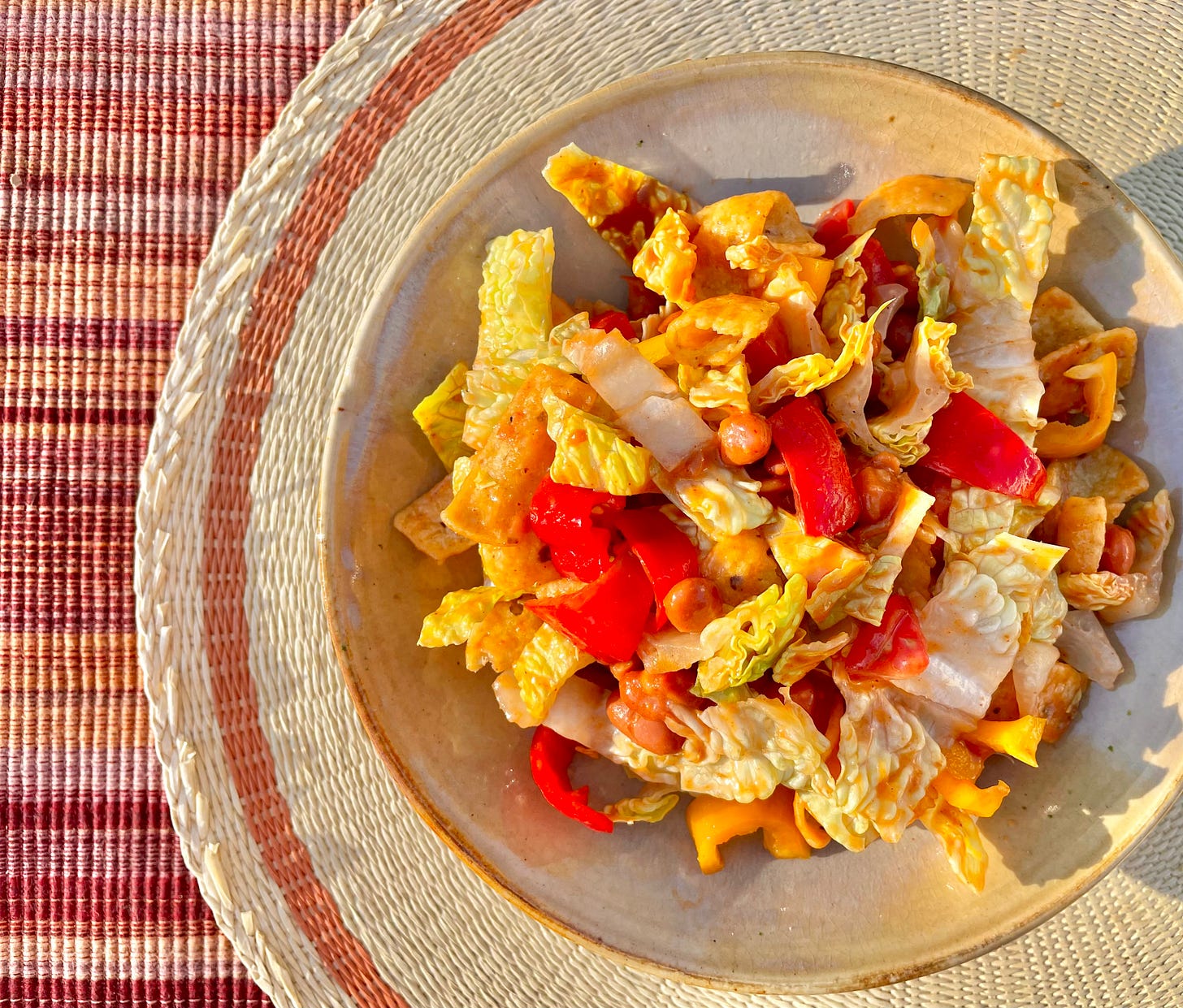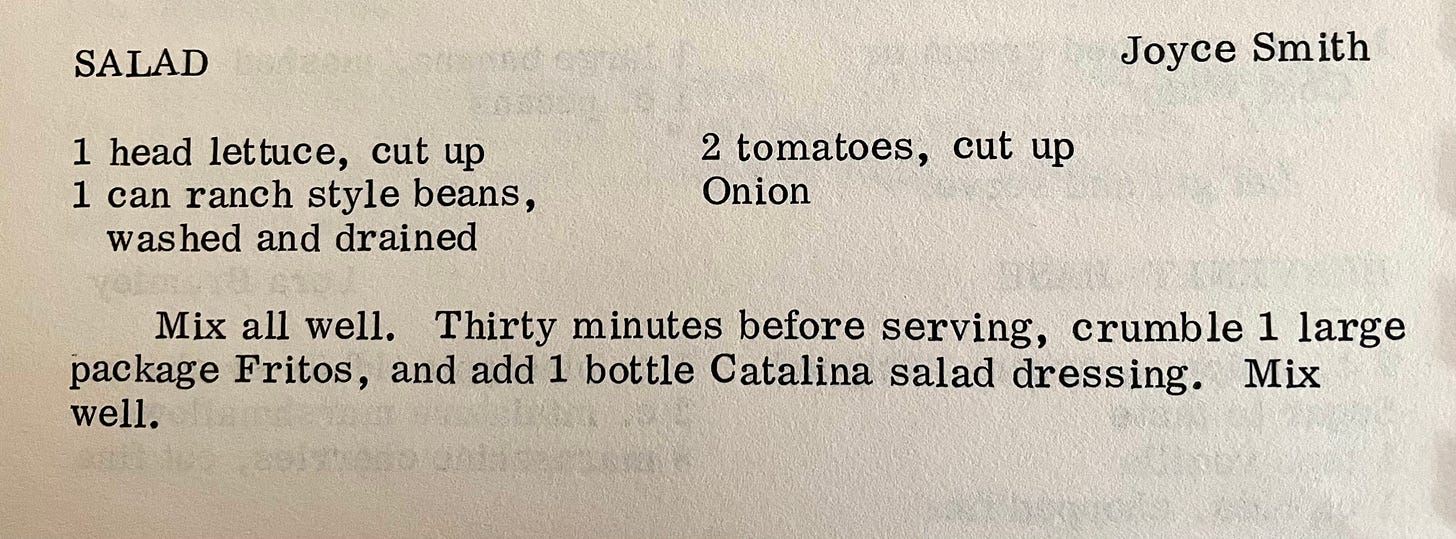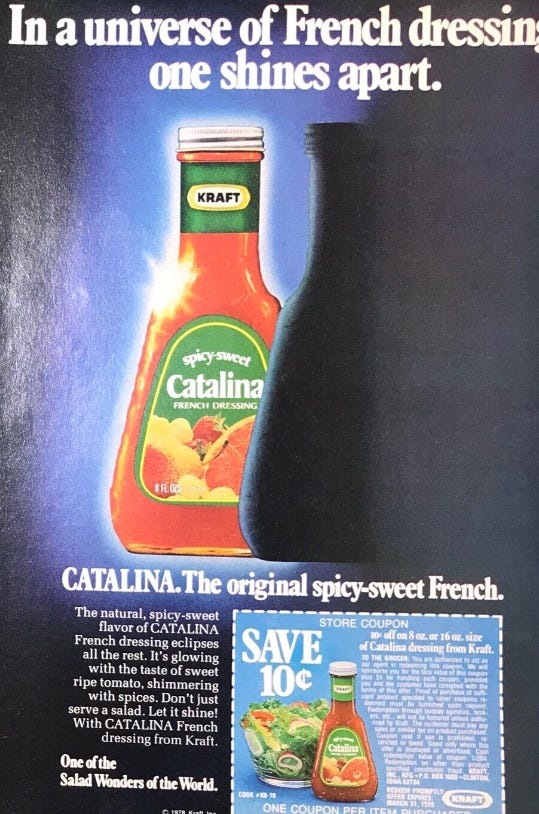Talk About Good Vintage Recipe Roulette: "Mexican Salad"
Which one of you had French dressing on your recipe roulette bingo card for this one?
Taco Salad is a perennial favorite — beans or meat, rice, cheese, lettuce, tomato, sour cream, salsa and guac, all in a delicious crispy tortilla bowl. It’s a thing of beauty.
It’s also a thing of Texas, according to Gustavo Arellano, hilariously beloved ¡Ask a Mexican! columnist of many years, and author of Taco USA: How Mexican Food Conquered America. That book is a must-read, and it recounts the history of the invention of taco salad, from the development of Fritos by San Antonio restaurateur Gustavo Olguin, to the sale of the rights to businessman Charles Doolin, to Doolin’s 1949 bowl-shaped and taco-filled Fritos “Tacup”, sold initially only at Dallas-area Dairy Marts. When Doolin opened Casa de Fritos restaurant in 1955, the Tacup became a Disneyland staple.
The 70s never met a good menu idea it couldn’t ruin, so perhaps it’s no surprise that the taco salads in my grandmother’s 1975 Bogota, TX church cookbook leave something to be desired.
Namely, the tacos.
I’m proud to say that a cousin of mine had a taco salad entry that is remarkably respectable by 20th century Tex-Mex standards, with green chiles, avocado, and no Kraft anything of any kind, but the other versions all seem to be riffs on what I’m betting was a magazine advertisement recipe designed to increase sales of Fritos and/or salad dressing. (I suspect Fritos, whose recipe misadventures are well-documented.) There’s nothing wrong with that; it was the mid-century version of TikTok influencer recipes, turning the familiar into something fun and fast, but recipes written that way are little encapsulations of the fads from a specific time that rarely translate into good taste after a few decades. And then, they’re fun on a different level.
Those other versions pictured above mainly agree on the importance of putting surprise ingredients in the instructions — I always chuckle about it, but that’s one aspect of community recipes I find truly endearing.
If you read very carefully, then, you’ll see they also agree on shredded lettuce, beans, and corn chips, as well as…French-style dressing? Why is this in a Mexican salad? It’s indefensible, and I refuse to try to justify whichever food manufacturer wrote it. The last one wants you to simmer it (shudder) into a sort of cursed bolognese. It does at least have chili powder, but that’s the only thing it has going for it. As far as I can tell, you’re supposed to toss hot Kraft sauce with cold lettuce? Yikes on a cracker.
The other two use a type of canned bean common in Texas called ranch beans — pintos in a delightful and flavorful tomato-chile sauce — so naturally you rinse all of that off and replace it with ketchup dressing. Best two out of three means Catalina wins the dressing battle against the verrrrry slightly less spicy plain French, so here are the main ingredients, minus the onion because the mucilaginous layer in raw chopped makes my skin crawl:
It’s starting to dawn on me what this is going to taste like.
Kraft marketed Catalina as a sub-type of French dressing at first, calling it “Catalina French” and differentiating it by calling it “spicy sweet”. Perusing the ingredients, I’m at something of a loss to explain the “spicy” part, because the closest thing I see in the ingredients is garlic powder, but it’s pretty easy to spot the “sweet” — corn syrup came to prominence in the 70s, and it hasn’t given an inch of ground in the days following.
Since a vegetarian version is offered, I’m going to take it, and I’ll make just a quarter of the recipe — I do my best to eat what I make for these insane experiential history meals I insist on making, and I do not want leftovers. The various recipes call for somewhere between a 1/2 c. of dressing and…the whole bottle. The bottle in the 70s was 8 oz., which is an amount described in technical dietetic terms as “bookoo”. That means 1/4 c. of dressing, for about a tablespoon of sugar in my dinner salad.
Two of the recipes are totally devoid of corn chip serving guidance, but one specifies a “large package”. In the 70s, The 15-cent bag was 3/4 oz, and the 37-cent bag was 6 oz. As far as I’m aware, that was the largest bag, and it seems about right by volume for a head of lettuce.
It’s incredibly simple to assemble: just tear the lettuce, chop a few veggies, rinse the last remaining bits of anything with a prayer of devoting even a smidge of flavor off of the beans, and mix everything together.
One of the recipes instructs you to let it sit for 30 minutes after mixing, so I let it sit for 10, and I’m really, really sorry I did. Marinated Fritos have the texture of wet cat litter.
The “spicy sweet” has zero spice. This salad has never even heard of spices. It thinks the world is flat and the Dutch East India Company went to war over applesauce. What it lacks in spicy, though, it more than makes up for with sweet. The flavors of the vegetables are completely and totally obscured by plain ol’ sugar. You can’t even really taste the tomato in the dressing. It’s very very sweet, somewhere in the range of a bowl of Froot Loops. You might think that’s unfair hyperbole against this salad, but it’s actually unfair to Froot Loops, which have only 2/3 the added sugar.
Froot Loops are spicier, too.










